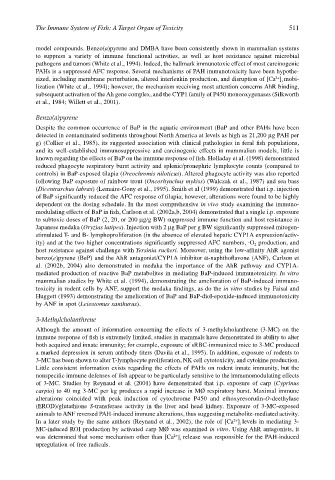Page 531 - The Toxicology of Fishes
P. 531
The Immune System of Fish: A Target Organ of Toxicity 511
model compounds. Benzo(a)pyrene and DMBA have been consistently shown in mammalian systems
to suppress a variety of immune functional activities, as well as host resistance against microbial
pathogens and tumors (White et al., 1994). Indeed, the hallmark immunotoxic effect of most carcinogenic
PAHs is a suppressed AFC response. Several mechanisms of PAH immunotoxicity have been hypothe-
2+
sized, including membrane perturbation, altered interleukin production, and disruption of [Ca ] mobi-
i
lization (White et al., 1994); however, the mechanism receiving most attention concerns AhR binding,
subsequent activation of the Ah gene complex, and the CYP1 family of P450 monooxygenases (Silkworth
et al., 1984; Willett et al., 2001).
Benzo(a)pyrene
Despite the common occurrence of BaP in the aquatic environment (BaP and other PAHs have been
detected in contaminated sediments throughout North America at levels as high as 21,200 µg PAH per
g) (Collier et al., 1985), its suggested association with clinical pathologies in feral fish populations,
and its well-established immunosuppressive and carcinogenic effects in mammalian models, little is
known regarding the effects of BaP on the immune response of fish. Holladay et al. (1998) demonstrated
reduced phagocyte respiratory burst activity and splenic/pronephric lymphocyte counts (compared to
controls) in BaP-exposed tilapia (Oreochromis niloticus). Altered phagocyte activity was also reported
following BaP exposure of rainbow trout (Oncorhynchus mykiss) (Walczak et al., 1987) and sea bass
(Dicentrarchus labrax) (Lemaire-Gony et al., 1995). Smith et al (1999) demonstrated that i.p. injection
of BaP significantly reduced the AFC response of tilapia; however, alterations were found to be highly
dependent on the dosing schedule. In the most comprehensive in vivo study examining the immuno-
modulating effects of BaP in fish, Carlson et al. (2002a,b, 2004) demonstrated that a single i.p. exposure
to subtoxic doses of BaP (2, 20, or 200 µg/g BW) suppressed immune function and host resistance in
Japanese medaka (Oryzias latipes). Injection with 2 µg BaP per g BW significantly suppressed mitogen-
stimulated T- and B- lymphoproliferation (in the absence of elevated hepatic CYP1A expression/activ-
–
ity) and at the two higher concentrations significantly suppressed AFC numbers, ·O production, and
2
host resistance against challenge with Yersinia ruckeri. Moreover, using the low-affinity AhR agonist
benzo(e)pyrene (BeP) and the AhR antagonist/CYP1A inhibitor α-naphthoflavone (ANF), Carlson et
al. (2002b, 2004) also demonstrated in medaka the importance of the AhR pathway and CYP1A-
mediated production of reactive BaP metabolites in mediating BaP-induced immunotoxicity. In vitro
mammalian studies by White et al. (1994), demonstrating the amelioration of BaP-induced immuno-
toxicity in rodent cells by ANF, support the medaka findings, as do the in vitro studies by Faisal and
Huggett (1993) demonstrating the amelioration of BaP and BaP-diol-epoxide-induced immunotoxicity
by ANF in spot (Leiostomus xanthurus).
3-Methylcholanthrene
Although the amount of information concerning the effects of 3-methylcholanthrene (3-MC) on the
immune response of fish is extremely limited, studies in mammals have demonstrated its ability to alter
both acquired and innate immunity; for example, exposure of sRBC-immunized mice to 3-MC produced
a marked depression in serum antibody titers (Davila et al., 1995). In addition, exposure of rodents to
3-MC has been shown to alter T-lymphocyte proliferation, NK cell cytotoxicity, and cytokine production.
Little consistent information exists regarding the effects of PAHs on rodent innate immunity, but the
nonspecific immune defenses of fish appear to be particularly sensitive to the immunomodulating effects
of 3-MC. Studies by Reynaud et al. (2001) have demonstrated that i.p. exposure of carp (Cyprinus
carpio) to 40 mg 3-MC per kg produces a rapid increase in MØ respiratory burst. Maximal immune
alterations coincided with peak induction of cytochrome P450 and ethoxyresorufin-O-deethylase
(EROD)/glutathione S-transferase activity in the liver and head kidney. Exposure of 3-MC-exposed
animals to ANF reversed PAH-induced immune alterations, thus suggesting metabolite-mediated activity.
2+
In a later study by the same authors (Reynaud et al., 2002), the role of [Ca ] levels in mediating 3-
i
MC-induced ROI production by activated carp MØ was examined in vitro. Using AhR antagonists, it
2+
was determined that some mechanism other than [Ca ] release was responsible for the PAH-induced
i
upregulation of free radicals.

